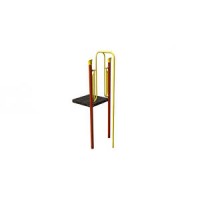Sliding Pole

Public Playground Safety Handbook
CPSC Publication 325
U.S. Consumer Product Safety Commission
5.3.2.6 Sliding poles
Vertical sliding poles are more challenging than some other types of climbing equipment. They require upper body strength and coordination to successfully slide down the pole. Unlike other egress methods, there is no reverse or stop, so a child cannot change his or her mind. Children who start a sliding pole must have the strength to slide the whole way or they will fall.
• Sliding poles are not recommended for toddlers or preschool-age children since they generally don't have the upper body and/or hand strength to slide.
• Sliding poles should be continuous with no protruding welds or seams along the sliding surface.
• The pole should not change direction along the sliding portion.
• The horizontal distance between a sliding pole and any structure used for access to the sliding pole should be between 18 inches and 20 inches.
• The pole should extend at least 60 inches above the level of the platform or structure used for access to the sliding pole.
• The diameter of sliding poles should be no greater than1.9 inches.
• Sliding poles and their access structures should be located so that traffic from other events will not interfere with the users during descent.
• Upper access should be on one level only.
• The upper access area through the guardrail or barrier should be 15 inches wide at most.
5.3.2.6.1 Fall height
• For sliding poles accessed from platforms, the fall height is the distance between the platform and the protective surfacing beneath it.
• For sliding poles not accessed from platforms, the fall height is the distance between a point 60 inches below the highest point of the pole and the protective surfacing beneath it.
• The top of the sliding pole’s support structure should not be a designated play surface.
